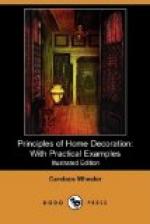This throws us back upon cottons and linens for inexpensive hangings, and in all the thousand forms in which these two fibres are manufactured it would seem easy to choose those which are beautiful, durable, and appropriate. But here we are met at the very threshold of choice with the two undesirable qualities of fugitive colour, and stiffness of texture. Something in the nature of cotton makes it inhospitable to dyes. If it receives them it is with a protest, and an evident intention of casting them out at the earliest opportunity—it makes, it is true, one or two exceptions. It welcomes indigo dye and will never quite relinquish its companionship; once received, it will carry its colours through all its serviceable life, and when it is finally ready to fall into dust, it is still loyally coloured by its influence. If it is cheated, as we ourselves are apt to be, into accepting spurious indigo, made up of chemical preparations, it speedily discovers the cheat and refuses its colouring. Perhaps this sympathy is due to a vegetable kinship and likeness of experience, for where cotton will grow, indigo will also flourish.
In printed cottons or chintzes, there is a reasonable amount of fidelity to colour, and if chintz curtains are well chosen, and lined to protect them from the sun, their attractiveness bears a fair proportion to their durability.
An interlining of some strong and tried colour will give a very soft and subtle daylight effect in a room, but this is, of course, lost in the evening. The expedient of an under colour in curtain linings will sometimes give delightful results in plain or unprinted goods, and sometimes a lining with a strong and bold design will produce a charming shadow effect upon a tinted surface—of course each new experiment must be tried before one can be certain of its effect, and, in fact, there is rather an exciting uncertainty as to results. Yet there are infinite possibilities to the householder who has what is called the artistic instinct and the leisure and willingness to experiment, and experiments need not be limited to prints or to cottons, for wonderful combinations of colour are possible in silks where light is called in as an influence in the composition. One must, however, expect to forego these effects except in daylight, but as artificial light has its own subtleties of effect, the one can be balanced against the other. In my own country-house I have used the two strongest colours—red and blue—in this doubled way, with delightful effect. The blue, which is the face colour, presenting long, pure folds of blue, with warmed reddish shadows between, while at sunset, when the rays of light are level, the variations are like a sunset sky.
It will be seen by these suggestions that careful selection, and some knowledge of the qualities of different dyes, will go far toward modifying the want of permanence of colour and lack of reflection in cottons; the other quality of stiffness, or want of flexibility, is occasionally overcome by methods of weaving. Indeed, if the manufacturer or weaver had a clear idea of excellence in this respect, undoubtedly the natural inflexibility of fibre could be greatly overcome.




